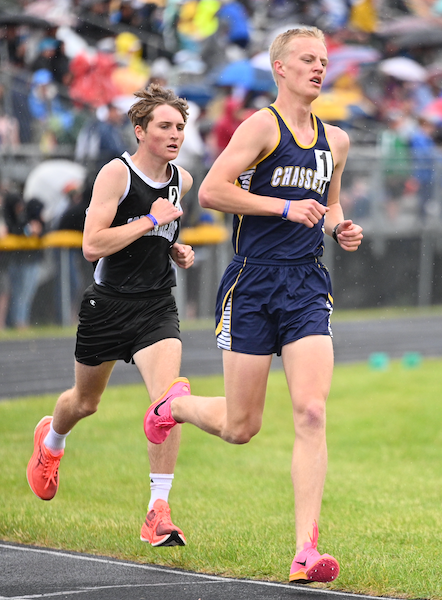
Track Gaining Speed Toward Future with Electronic Starting Devices
By
Steve Vedder
Special for MHSAA.com
May 23, 2023
Aubrey Greenfield thinks it might be the perfect time to reevaluate 130 years of tradition.
For a number of reasons, from technical to personal, the Oxford senior sprinter believes it makes sense for the crack of a starting pistol to be eliminated from high school track meets.
Because track meets would benefit in various ways from lowering costs to easier setup at meets to the human factor of competitors not having to flinch at the crack of a pistol shot, Greenfield believes the sport has a chance to embrace new technology – electronic starting devices (ESD).
In essence, an ESD replaces the starting pistol with a light flash, tone sound or both to begin a race.
"High school sports should put the athlete first," Greenfield said. "We should promote sports, and eliminating starting pistols promotes health in terms of PTSD or trauma for athletes and spectators and that would be good. I would like to think people would say that's a good idea."
In fact, Greenfield would go as far as to say if there was not an implementation of electronic starting devices, many of her teammates would have considered giving up the sport.
"If it's something that helps us compete safely, we're all for it," she said.
Greenfield's opinion apparently is spreading. Michigan High School Athletic Association senior assistant director Cody Inglis said the use of ESD makes it both affordable for meet starters and sensible for athletes and fans to rethink the use of starting pistols. While the MHSAA is not mandating electronic starting devices, it does promote the use of what Inglis calls "emerging technology." He notes that ESD are becoming the norm for organizations such as USA Track & Field, the NCAA and an increasing number of high schools.
 "I think we have to embrace new technology, and we think this will be something that takes hold," Inglis said.
"I think we have to embrace new technology, and we think this will be something that takes hold," Inglis said.
A key part of embracing ESD is the human element. The tragic Oxford High School shooting Nov. 30, 2021, that took the lives of four students while injuring seven others should not be relived even for a fleeting instance at a high school sporting event. Oxford athletic director Tony DeMare said the school began using ESD at every meet, including the MHSAA Lower Peninsula Division 1 Finals last June. He said that decision was embraced by virtually all schools Oxford encountered.
"We were very convinced that the alternative (of ESD) would promote a healthy attitude," DeMare said. "We were overwhelmed with the positive response. If a school was on the fence about it or might not be for it, I think we've started to see the tide turn in favor of people willing to listen and learn about electronic starting devices."
Inglis said the MHSAA is acutely aware of what the crack of a starting pistol can mean to athletes and fans.
"It's unimaginable what Oxford went through, and this is a small way we can help," he said. "We look at a (starting pistol) and think, ‘Could we do something else?’ It's a way of helping to solve a problem."
Over the last several years, the MHSAA has embraced finding an alternative to starting pistols. Inglis noted the discussion started with the cost and diminishing availability of 32-caliber ammunition that meet starters use. A box of ammunition, if it can be found, is around $75 a box.
In addition to cost, there is potential damage from excessive exposure to 150-plus decibels of sound generated by the traditional 32-caliber blanks. Medical studies show damage to ears caused by decibel levels above 120 dB.
The tragedy at Oxford accelerated the conversation.
Inglis said the cost of ESD can be likened to a school sinking money into artificial surfaces at football fields. Yes, there is a great cost at first, but over time money is ultimately saved. An ESD system itself ranges between $200 and $500. Speakers also may need to be purchased, but with ESD starting events like the 800 and 1,600-meter relays positioned near the outside lanes 8, 7, 6 and 5 would result in improved hearing by athletes at the start of a race.
There is one challenge with ESD that track administrators are working to overcome – lighting conditions that lessen the ability to see the ESD’s LED light or strobe when the button is pressed by a starter to begin a race. But that vision difficulty resulting from clear blue skies and backgrounds of setting suns can be substantially improved by incorporating a black background with an ESD – something as simple as a starter holding up black cardboard behind the lighting mechanism at the start of an event.
Inglis said when all factors are considered, the use of ESD makes sense.
 "With the climate we live in nowadays, no lookalike guns is good," he said. "We're not mandating this. But people are saying this is affordable."
"With the climate we live in nowadays, no lookalike guns is good," he said. "We're not mandating this. But people are saying this is affordable."
While switching to ESD would break 130 years of tradition, the timing could be a step forward, said Jeff Hollobaugh, co-author of the book "The Fleet Feet of Spring: Michigan's High School State Championships in Track & Field." He said while no definitive answer is possible, it's likely starting pistols were used at the inaugural state meet at the Jackson Fairgounds in 1895. The meet, which included events like tossing a 16-pound shot put, bike races and a 100-meter sprint, was sponsored by the Michigan Interscholastic Athletic Association (a predecessor to the MHSAA) and comprised mostly of the state's larger schools.
Hollobaugh's sentiments echo what many involved in today's high school track & field believe in terms of making a transition from starting pistols to electronic starting devices.
"It's a change, not necessarily good or bad, just different," he said. "It's not a drastic change, but it will take some getting used to. But it is the future. In the end, we'll all be fine."
DeMare believes the future of high school track will definitely include ESD.
"Our desire is that the practicality and sensibility of this will overcome the alternative," he said. "I think we'll see the automation and electronics taking hold of certain elements in track, and people will embrace it."
PHOTOS (Top) Runners watch official Bertha Smiley as they prepare to begin a race during last season's Lower Peninsula Division 1 Finals at Rockford. (Middle) An electronic starting device provided by VS Athletics was used to start those races. (Below) Smiley sets to begin an event. (Photos provided by David Kuderka/VS Athletics.)

With 2nd Place in Final Race, Newberry Clinches 1st in Final Team Standings
By
John Vrancic
Special for MHSAA.com
June 2, 2024
KINGSFORD — The race for the Upper Peninsula Division 3 boys track & field championship came right down to the wire Saturday as Newberry edged St. Ignace 96-92 for top honors.
Third-place team finisher Lake Linden-Hubbell won the day’s final race, the 1,600-meter relay, in 3 minutes, 41.94 seconds, and Newberry hung on to edge St. Ignace by two steps for second place and its first title in eight years.
Newberry, which was runner-up to Munising last year, was clocked at 3:43.07 in the 1,600 relay on this sunny and mild late afternoon. The Saints finished nine hundredths of a second later.
“We knew we had to beat St. Ignace to win,” Newberry senior Kennedy Depew said after finishing the anchor leg. “This was my last race ever. I knew I had to give it my all. That’s also why I knew I had to scratch from the open 400. I would have been in four events. I think scratching from the 400 helped me save some energy. We weren’t satisfied with runner-up last year, which makes this year’s championship all the more satisfying.”
Classmate Gabe Luck provided Newberry with its lone individual first with a heave of 44 feet, 1¾ inches in shot put.
“We had a lot of injuries this year,” Newberry coach Drew Schultz said. “For all the obstacles we had, we wouldn’t have it any other way, having two of the best athletes decide it in the last race. I’m extremely proud of our guys. To win it that way is just insane. I’m proud of all our eastern-end kids.”
 Depew also was runner-up in the 100-meter dash in 11.63 seconds.
Depew also was runner-up in the 100-meter dash in 11.63 seconds.
Senior Jon Ingalls, who ran the last leg for the Saints, won the 110 hurdles (16.39) and 300s (42.89) and helped them place second in the 400 relay (45.94).
“Both hurdles were decent,” Ingalls said. “Those weren’t my best times, but it feels good to grind out a few more wins.”
Senior Owen Lester also provided the Saints with a victory in pole vault (12-6).
LL-H got firsts from senior Gabe Popko in discus at 153 feet, 4¼ inches, and classmate Matt Jokela in the 400 (51.09). Jokela also took third in the 100 (11.65).
“Real good hydration and confidence are keys,” Jokela said. “I think having confidence helps a little. I usually don’t go too hard out of the blocks. Then, I usually try to go as hard as I can in the last 200.”
Chassell junior Kalvin Kytta claimed three firsts, taking the 800 in a personal-best 2:03.62, 1,600 (4:39.58) and 3,200 (10:27.32).
“Three wins, I’m pretty happy with that,” he said. “The 800 went real well. Overall, I’m very happy with my performance today.”
Fourth-place Bessemer set UPD3 Finals records in the 400 relay (45.3) and 800 (1:34.64). Powers North Central previously set the record in the 400 (45.34) two years ago and Rock Mid Peninsula had held the 800 record since 2001 when it ran a 1:35.1.
“We shaved two seconds off in the 800 relay which feels good, and our handoffs in the 400 were good all year,” Bessemer senior Landon Peterson said. “Our school record in the 400 is 44.98, which is something we’ve done three times this year. Running on a rubber track gives you a much better grip, which helped us a lot today.”
Bessemer senior Tom Trudgeon became a four-event winner, also taking the 100 (11.46) and 200 (23.85).
Crystal Falls Forest Park freshman Vic Guiliani won high jump (6-0), and sophomore Michael Rexford went 19-9 in long jump, providing Escanaba Holy Name with its first U.P. Finals title since the school reopened in 2021.
PHOTOS (Top) Newberry runners celebrate taking second place in the 1,600 relay, allowing them to finish ahead of St. Ignace for the team title in Upper Peninsula Division 3. (Middle) Chassell's Kalvin Kytta and Cedarville/DeTour's Ethan Snyder lead the pack of 1,600 runners. (Click for more from Cara Kamps/RunMichigan.com.)

